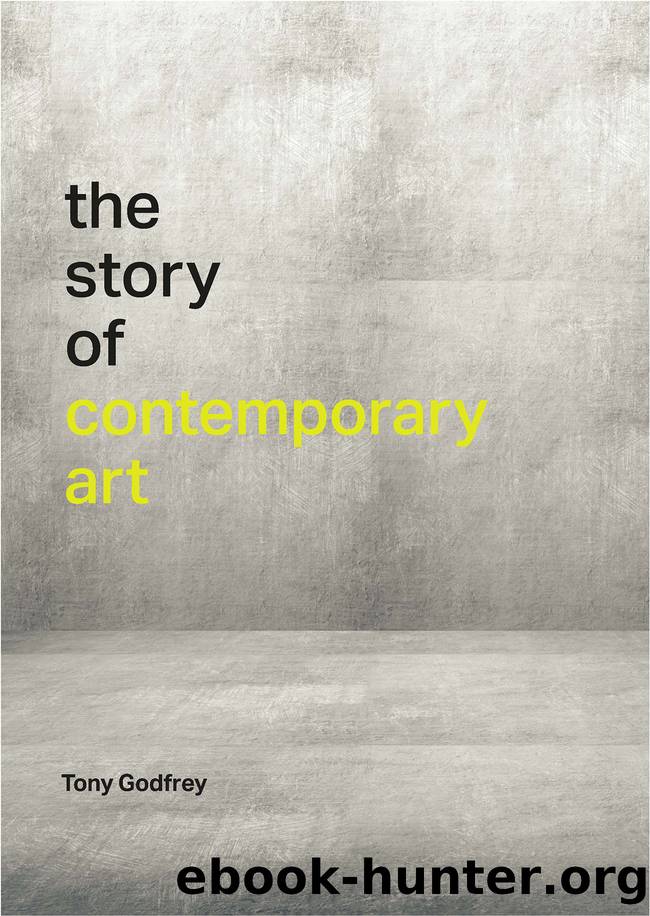The Story of Contemporary Art by Tony Godfrey

Author:Tony Godfrey
Language: eng
Format: epub
Publisher: MIT Press
Published: 2020-11-15T00:00:00+00:00
Bruce Nauman, Mapping the Studio I (Fat Chance John Cage), 2001
Video installation with 7 DVDs, 7 DVD players, 7 projectors, 7 pairs of speakers, as installed at Dia:Chelsea, New York, 2002
El Anatsui, Dusasa II, 2007
Found aluminium and copper wire, 546.1 Ã 655.3 cm (215 Ã 258 in.), installation view, Venice Biennale
The Ghanaian sculptor El Anatsui, with the help of up to twenty assistants, will flatten aluminium bottle tops and string them together with wire. These are then formed into large â often very large â sculptures. Perhaps we can call them metal tapestries. They are very attractive, and much sought after by collectors; indeed, Anatsui may now be the best-selling African artist. There is surprisingly little interest in his career before 2000, which is when he started working with bottle tops, but from the 1960s he had been working with wood or broken pots in ways that took from both traditional African modes and modernism.
Speaking in 2006, Anatsui said: âPeople at times see my works without any knowledge of their context or even their titles, and they create their own meanings out of them. Some interpretations reveal how close we are as humans. I would agree that context is both an aid and a hindrance. In certain ways, it helps to anchor a message, and depending on the viewerâs capacity and experience, he could go from there to expand or simply stop. I donât think that I define myself strictly in a locational context.â18 He is relaxed about these differing interpretations, often titling his pieces in his own language, Ewe, knowing few people will understand it.
Much of Anatsuiâs work has been about using everyday things: âI look for things that are immediately available, thereby sustaining my practice. I am drawn more to materials that have been subjected to considerable human use: mortars, trays, graters, tins, and, of late, liquor bottle tops.â19 Their history is important to him: âI wanted to work with materials that had been used, that people had put their hands on ⦠When working with materials that have such history, the process has some kind of connective energy: the energy of all the people who have interacted with them.â20 But he wants to make them new again: âIn my practice, I transform the media; I give them a new lease on life ⦠My processes are rather basic too, very much a part of everyday life. Working with bottle caps requires the most rudimentary of means.â21 Behind everything Anatsui does is an appeal to materials, to things he can find and, as he notes, transform.
In 1973 Bruce Nauman stopped making films and videos. Fifteen years later, he started making them again, but not of himself. Instead, he filmed actors in staged, often cruel or repetitive scenarios. In Mapping the Studio (page 166), the âactorsâ are, in theory, some mice and Naumanâs cat. In practice, when the work is installed properly, the viewer is the actor.
In 2001 Nauman had a problem: field mice were getting into his studio and his cat was not dealing with them.
Download
This site does not store any files on its server. We only index and link to content provided by other sites. Please contact the content providers to delete copyright contents if any and email us, we'll remove relevant links or contents immediately.
The Japanese by Christopher Harding(1085)
Watercolor With Me in the Forest by Dana Fox(753)
A Theory of Narrative Drawing by Simon Grennan(742)
The Story of the Scrolls by The Story of the Scrolls; the M(725)
Glittering Images: A Journey Through Art From Egypt to Star Wars by Camille Paglia(717)
Boris Johnson by Tom Bower(620)
This Is Modern Art by Kevin Coval(597)
The Art and Science of Drawing by Brent Eviston(588)
Frida Kahlo by Frida Kahlo & Hayden Herrera(584)
AP Art History by John B. Nici(574)
Banksy by Will Ellsworth-Jones(569)
War Paint by Woodhead Lindy(551)
Van Gogh by Gregory White Smith(547)
Draw More Furries by Jared Hodges(544)
About Looking by John Berger(543)
Scenes From a Revolution by Mark Harris(542)
Ecstasy by Eisner.;(535)
100 Greatest Country Artists by Hal Leonard Corp(523)
Young Rembrandt: A Biography by Onno Blom(512)
